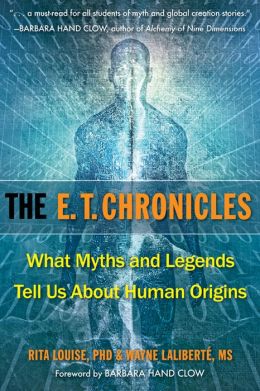This is one of the most fascinating works of comparative mythology I’ve ever read. Instead of just comparing a handful of myths from a few disparate cultures, the authors carefully correlate the creation stories and myths of the early world from every inhabited continent, matching up their timelines to show the startling amount of direct correspondence across cultures and around the world. I have to agree with the authors; the similarities among the worldwide creation tales are too great to be accounted for by mere coincidence.
The stated purpose of the book is to correlate the oldest worldwide myths and legends to find out what really happened in the far distant past and, perhaps, to discover where we humans really came from. The authors state up front that they’re offering ‘just the facts’ and will allow the reader to draw his or her own conclusions; happily, they do just that. Though the title and some comments within the book reveal that the authors believe the gods to be extraterrestrial beings of some sort, they do not push the matter but simply let the stories speak for themselves.
The authors begin with the creation stories found in the Bible because they’re familiar to most people, then they move on to the myths from the Fertile Crescent that form the foundation for the biblical tales, then legends from other cultures around the world. They identify some deities that appear in myths around the world – the Sky Father, the God of War, the Fertility God – and trace their actions in the stories. They also distinguish between the omnipotent/omniscient creator-god who is distant from humans and the deities who take on physical form, interact with people and can die or be killed. One point I found interesting is that, while the gods and goddesses visit the Earth, they never live here; their home is always in the heavens or the Underworld. Worldwide, all mythologies talk about different levels of existence above and below the Earth.
The most fascinating part of the book is the correlation between the timelines in the different creation stories. The authors state that they reviewed over 500 creation and flood legends from around the world and found matching timelines in all of them. They identify the Ages, Suns, Yugas and Worlds of the various myths and line them up for comparison at major points. They line up remarkably well, from Australia to the Americas to Europe to Asia. I do wish the authors had included some sort of chart showing the correlations; there was so much information, it was hard to hold it all in my head and I started taking notes just to keep my perspective. Regardless, I got goosebumps as I realized the extent to which the tales line up with each other.
A few of the worldwide parallels that caught my attention include the fact that the gods are fallible, not omnipotent, and rely on technology to achieve their goals; creation begins with a void and an egg, with the earliest beings (gods) part reptile, amphibian, or fish and often hermaphroditic; humans received the hallmarks of civilization (writing, agriculture) from the gods; a flood wiped out all but a few carefully chosen people and the animals they saved. The authors offer some possible dates for the flood based on geological evidence, any of which are quite reasonable, though none can be confirmed.
Obviously the authors have an opinion as to the nature of the gods – they believe them to be extraterrestrial beings who visited Earth in the distant past and interacted with humans for their own purpose. But it’s not necessary to agree with this view in order to enjoy the book and glean some great insights from it. If you enjoy comparative mythology in any form, this book will be a great read for you.
~review by Laura Perry
Authors: Rita Louise, Ph.D. and Wayne Laliberte, M.S.
Hampton Roads Publishing, 2014
pp. 218, $ 16.95
The E.T. Chronicles: What Myths and Legends Tell Us About Human Origins

©
2010 - 2025
Facing North
